Dental Nursing - First Aid, Oral Health, and Healthcare Systems
VerifiedAdded on 2020/12/24
|24
|6105
|325
Homework Assignment
AI Summary
This dental nursing assignment comprehensively addresses first aid protocols, oral health management, and patient care. It begins with an introduction to dental nursing and the role of first aiders, including their responsibilities and methods to minimize infection risks. The assignment details the importance of obtaining consent, identifying essential first aid equipment, and ensuring its safe usage. It includes a table of drugs used in dentistry and explores emergency treatments for conditions like angina, asthma, heart attacks, strokes, epilepsy, anaphylaxis, and fainting. Furthermore, the assignment delves into oral health planning, delivery methods, and factors influencing health and illness. It covers population health approaches, evidence-based prevention, health promotion strategies, and communication methods for diverse patient types. Additional topics include dental imaging resources, equipment, legal requirements, and ethical guidelines, concluding with a comprehensive overview of the GDC ethical and professional guidance.
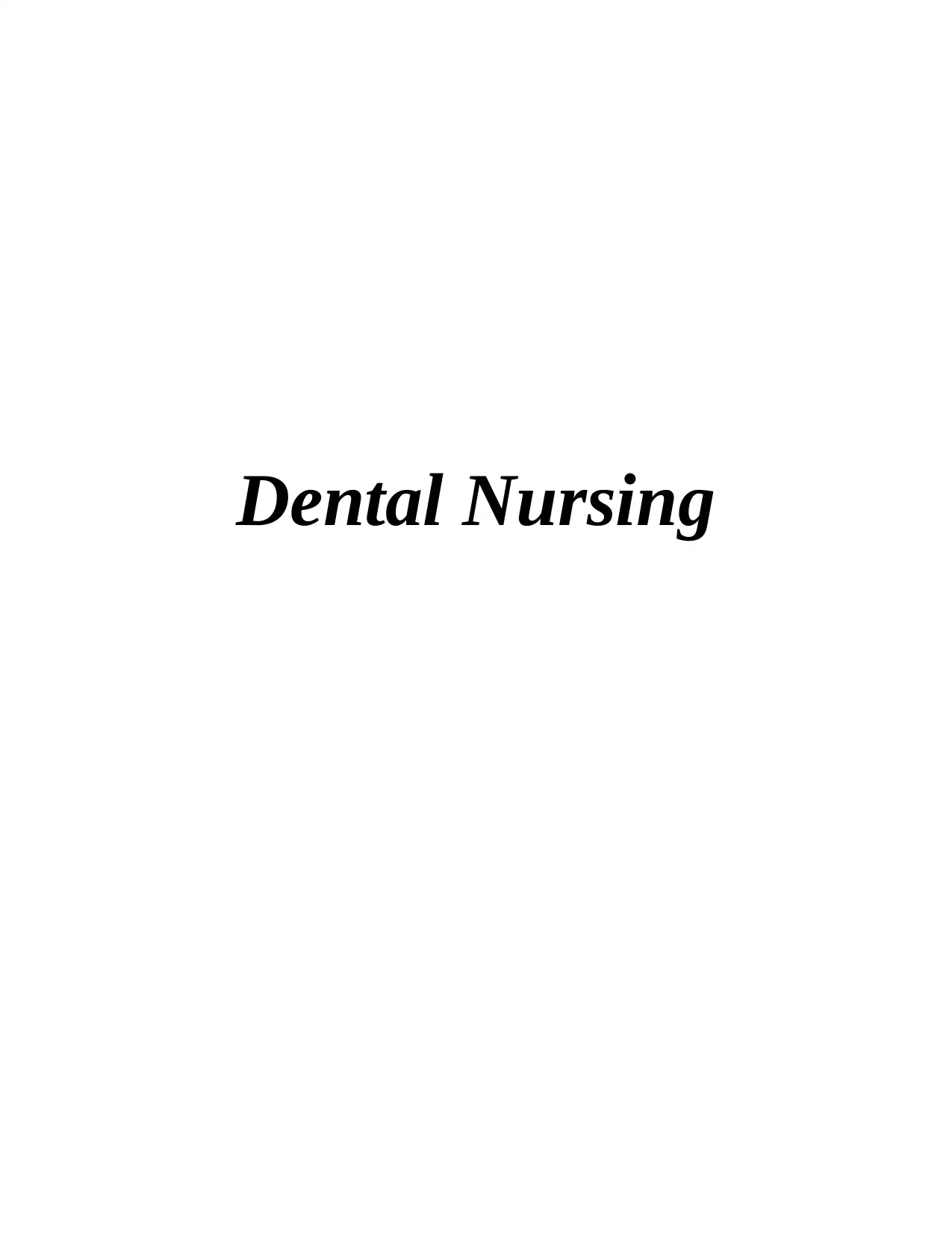
Dental Nursing
Paraphrase This Document
Need a fresh take? Get an instant paraphrase of this document with our AI Paraphraser
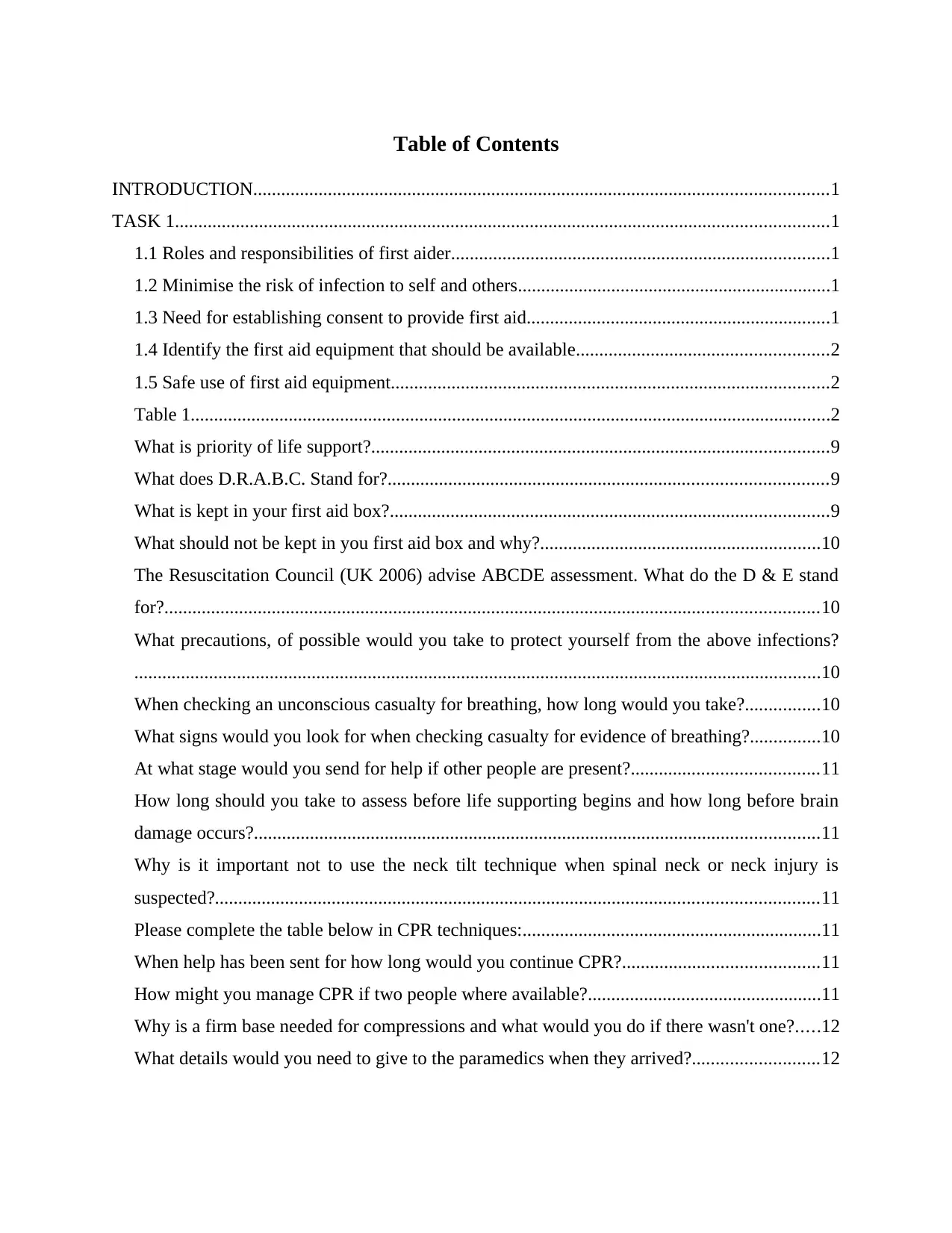
Table of Contents
INTRODUCTION...........................................................................................................................1
TASK 1............................................................................................................................................1
1.1 Roles and responsibilities of first aider.................................................................................1
1.2 Minimise the risk of infection to self and others...................................................................1
1.3 Need for establishing consent to provide first aid.................................................................1
1.4 Identify the first aid equipment that should be available......................................................2
1.5 Safe use of first aid equipment..............................................................................................2
Table 1.........................................................................................................................................2
What is priority of life support?..................................................................................................9
What does D.R.A.B.C. Stand for?..............................................................................................9
What is kept in your first aid box?..............................................................................................9
What should not be kept in you first aid box and why?............................................................10
The Resuscitation Council (UK 2006) advise ABCDE assessment. What do the D & E stand
for?............................................................................................................................................10
What precautions, of possible would you take to protect yourself from the above infections?
...................................................................................................................................................10
When checking an unconscious casualty for breathing, how long would you take?................10
What signs would you look for when checking casualty for evidence of breathing?...............10
At what stage would you send for help if other people are present?........................................11
How long should you take to assess before life supporting begins and how long before brain
damage occurs?.........................................................................................................................11
Why is it important not to use the neck tilt technique when spinal neck or neck injury is
suspected?.................................................................................................................................11
Please complete the table below in CPR techniques:................................................................11
When help has been sent for how long would you continue CPR?..........................................11
How might you manage CPR if two people where available?..................................................11
Why is a firm base needed for compressions and what would you do if there wasn't one?.....12
What details would you need to give to the paramedics when they arrived?...........................12
INTRODUCTION...........................................................................................................................1
TASK 1............................................................................................................................................1
1.1 Roles and responsibilities of first aider.................................................................................1
1.2 Minimise the risk of infection to self and others...................................................................1
1.3 Need for establishing consent to provide first aid.................................................................1
1.4 Identify the first aid equipment that should be available......................................................2
1.5 Safe use of first aid equipment..............................................................................................2
Table 1.........................................................................................................................................2
What is priority of life support?..................................................................................................9
What does D.R.A.B.C. Stand for?..............................................................................................9
What is kept in your first aid box?..............................................................................................9
What should not be kept in you first aid box and why?............................................................10
The Resuscitation Council (UK 2006) advise ABCDE assessment. What do the D & E stand
for?............................................................................................................................................10
What precautions, of possible would you take to protect yourself from the above infections?
...................................................................................................................................................10
When checking an unconscious casualty for breathing, how long would you take?................10
What signs would you look for when checking casualty for evidence of breathing?...............10
At what stage would you send for help if other people are present?........................................11
How long should you take to assess before life supporting begins and how long before brain
damage occurs?.........................................................................................................................11
Why is it important not to use the neck tilt technique when spinal neck or neck injury is
suspected?.................................................................................................................................11
Please complete the table below in CPR techniques:................................................................11
When help has been sent for how long would you continue CPR?..........................................11
How might you manage CPR if two people where available?..................................................11
Why is a firm base needed for compressions and what would you do if there wasn't one?.....12
What details would you need to give to the paramedics when they arrived?...........................12
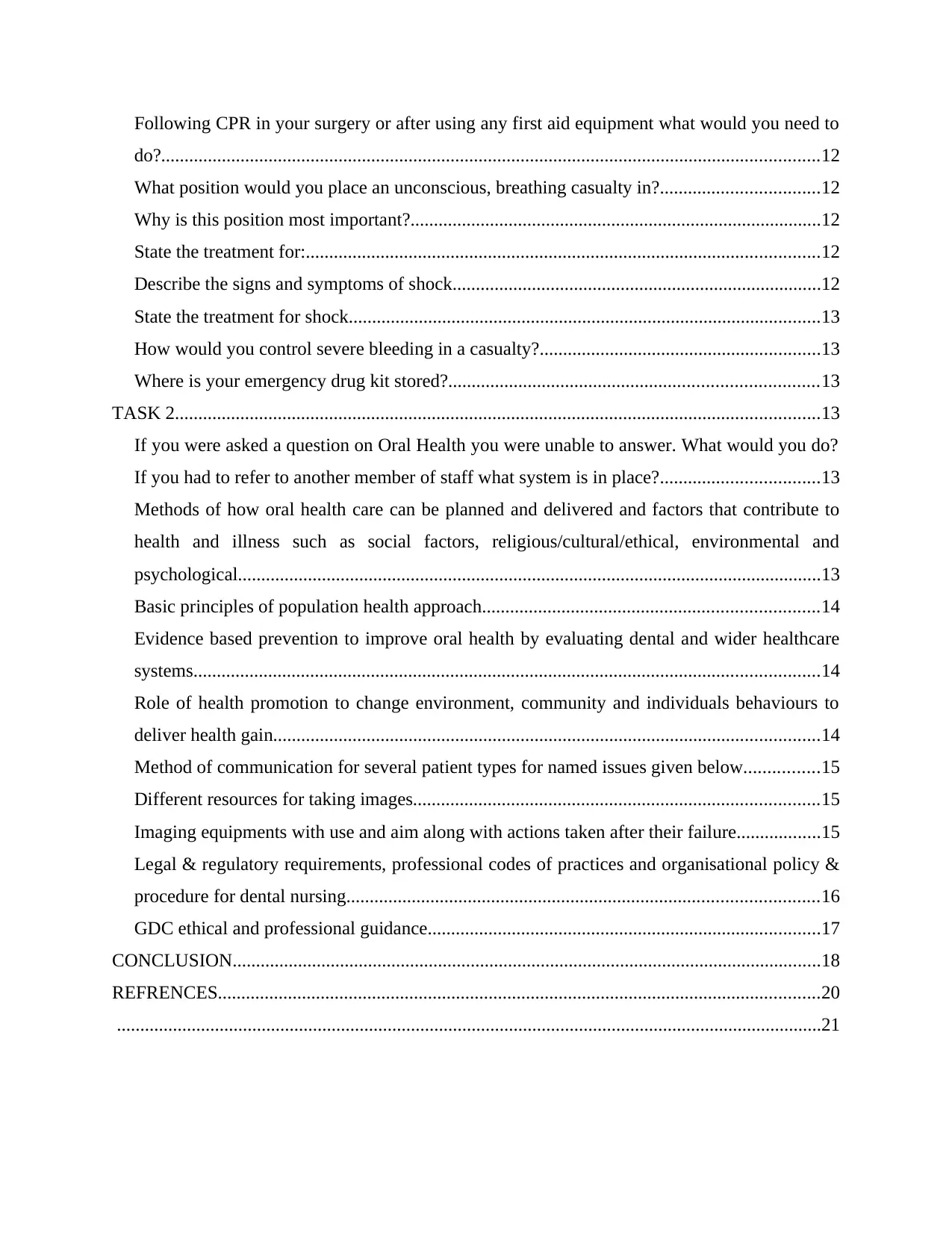
Following CPR in your surgery or after using any first aid equipment what would you need to
do?.............................................................................................................................................12
What position would you place an unconscious, breathing casualty in?..................................12
Why is this position most important?........................................................................................12
State the treatment for:..............................................................................................................12
Describe the signs and symptoms of shock...............................................................................12
State the treatment for shock.....................................................................................................13
How would you control severe bleeding in a casualty?............................................................13
Where is your emergency drug kit stored?...............................................................................13
TASK 2..........................................................................................................................................13
If you were asked a question on Oral Health you were unable to answer. What would you do?
If you had to refer to another member of staff what system is in place?..................................13
Methods of how oral health care can be planned and delivered and factors that contribute to
health and illness such as social factors, religious/cultural/ethical, environmental and
psychological.............................................................................................................................13
Basic principles of population health approach........................................................................14
Evidence based prevention to improve oral health by evaluating dental and wider healthcare
systems......................................................................................................................................14
Role of health promotion to change environment, community and individuals behaviours to
deliver health gain.....................................................................................................................14
Method of communication for several patient types for named issues given below................15
Different resources for taking images.......................................................................................15
Imaging equipments with use and aim along with actions taken after their failure..................15
Legal & regulatory requirements, professional codes of practices and organisational policy &
procedure for dental nursing.....................................................................................................16
GDC ethical and professional guidance....................................................................................17
CONCLUSION..............................................................................................................................18
REFRENCES.................................................................................................................................20
.......................................................................................................................................................21
do?.............................................................................................................................................12
What position would you place an unconscious, breathing casualty in?..................................12
Why is this position most important?........................................................................................12
State the treatment for:..............................................................................................................12
Describe the signs and symptoms of shock...............................................................................12
State the treatment for shock.....................................................................................................13
How would you control severe bleeding in a casualty?............................................................13
Where is your emergency drug kit stored?...............................................................................13
TASK 2..........................................................................................................................................13
If you were asked a question on Oral Health you were unable to answer. What would you do?
If you had to refer to another member of staff what system is in place?..................................13
Methods of how oral health care can be planned and delivered and factors that contribute to
health and illness such as social factors, religious/cultural/ethical, environmental and
psychological.............................................................................................................................13
Basic principles of population health approach........................................................................14
Evidence based prevention to improve oral health by evaluating dental and wider healthcare
systems......................................................................................................................................14
Role of health promotion to change environment, community and individuals behaviours to
deliver health gain.....................................................................................................................14
Method of communication for several patient types for named issues given below................15
Different resources for taking images.......................................................................................15
Imaging equipments with use and aim along with actions taken after their failure..................15
Legal & regulatory requirements, professional codes of practices and organisational policy &
procedure for dental nursing.....................................................................................................16
GDC ethical and professional guidance....................................................................................17
CONCLUSION..............................................................................................................................18
REFRENCES.................................................................................................................................20
.......................................................................................................................................................21
⊘ This is a preview!⊘
Do you want full access?
Subscribe today to unlock all pages.

Trusted by 1+ million students worldwide
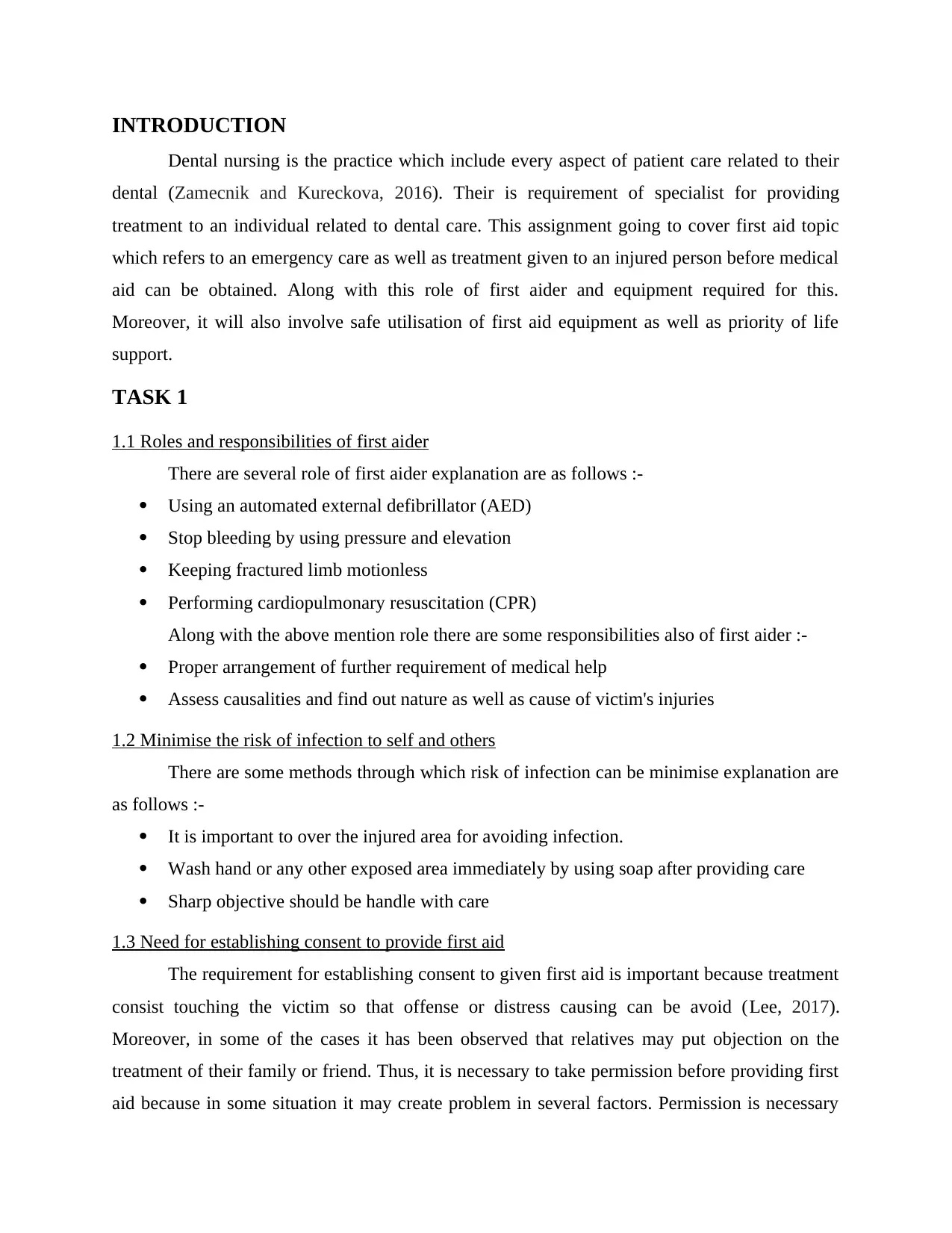
INTRODUCTION
Dental nursing is the practice which include every aspect of patient care related to their
dental (Zamecnik and Kureckova, 2016). Their is requirement of specialist for providing
treatment to an individual related to dental care. This assignment going to cover first aid topic
which refers to an emergency care as well as treatment given to an injured person before medical
aid can be obtained. Along with this role of first aider and equipment required for this.
Moreover, it will also involve safe utilisation of first aid equipment as well as priority of life
support.
TASK 1
1.1 Roles and responsibilities of first aider
There are several role of first aider explanation are as follows :-
Using an automated external defibrillator (AED)
Stop bleeding by using pressure and elevation
Keeping fractured limb motionless
Performing cardiopulmonary resuscitation (CPR)
Along with the above mention role there are some responsibilities also of first aider :-
Proper arrangement of further requirement of medical help
Assess causalities and find out nature as well as cause of victim's injuries
1.2 Minimise the risk of infection to self and others
There are some methods through which risk of infection can be minimise explanation are
as follows :-
It is important to over the injured area for avoiding infection.
Wash hand or any other exposed area immediately by using soap after providing care
Sharp objective should be handle with care
1.3 Need for establishing consent to provide first aid
The requirement for establishing consent to given first aid is important because treatment
consist touching the victim so that offense or distress causing can be avoid (Lee, 2017).
Moreover, in some of the cases it has been observed that relatives may put objection on the
treatment of their family or friend. Thus, it is necessary to take permission before providing first
aid because in some situation it may create problem in several factors. Permission is necessary
Dental nursing is the practice which include every aspect of patient care related to their
dental (Zamecnik and Kureckova, 2016). Their is requirement of specialist for providing
treatment to an individual related to dental care. This assignment going to cover first aid topic
which refers to an emergency care as well as treatment given to an injured person before medical
aid can be obtained. Along with this role of first aider and equipment required for this.
Moreover, it will also involve safe utilisation of first aid equipment as well as priority of life
support.
TASK 1
1.1 Roles and responsibilities of first aider
There are several role of first aider explanation are as follows :-
Using an automated external defibrillator (AED)
Stop bleeding by using pressure and elevation
Keeping fractured limb motionless
Performing cardiopulmonary resuscitation (CPR)
Along with the above mention role there are some responsibilities also of first aider :-
Proper arrangement of further requirement of medical help
Assess causalities and find out nature as well as cause of victim's injuries
1.2 Minimise the risk of infection to self and others
There are some methods through which risk of infection can be minimise explanation are
as follows :-
It is important to over the injured area for avoiding infection.
Wash hand or any other exposed area immediately by using soap after providing care
Sharp objective should be handle with care
1.3 Need for establishing consent to provide first aid
The requirement for establishing consent to given first aid is important because treatment
consist touching the victim so that offense or distress causing can be avoid (Lee, 2017).
Moreover, in some of the cases it has been observed that relatives may put objection on the
treatment of their family or friend. Thus, it is necessary to take permission before providing first
aid because in some situation it may create problem in several factors. Permission is necessary
Paraphrase This Document
Need a fresh take? Get an instant paraphrase of this document with our AI Paraphraser
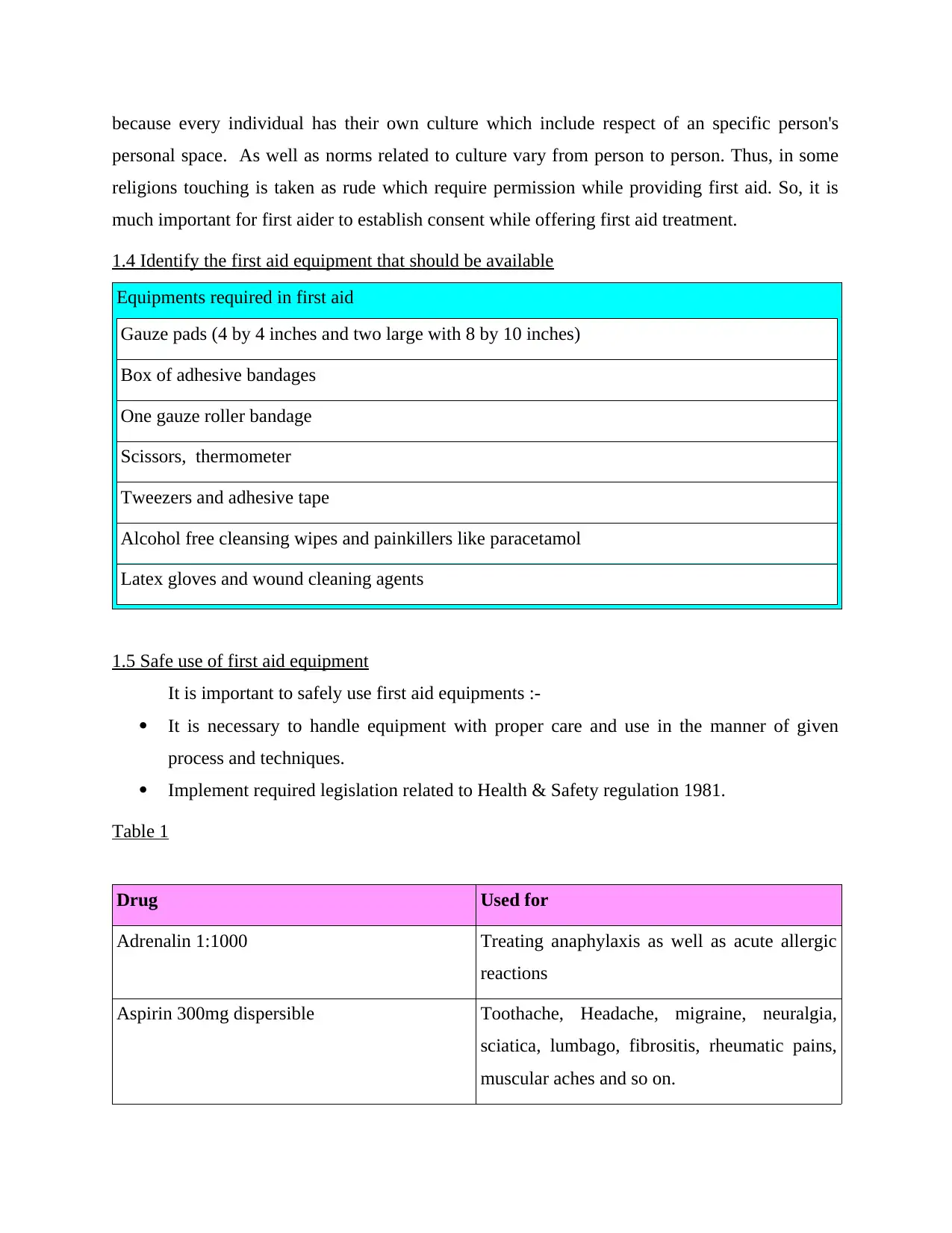
because every individual has their own culture which include respect of an specific person's
personal space. As well as norms related to culture vary from person to person. Thus, in some
religions touching is taken as rude which require permission while providing first aid. So, it is
much important for first aider to establish consent while offering first aid treatment.
1.4 Identify the first aid equipment that should be available
Equipments required in first aid
Gauze pads (4 by 4 inches and two large with 8 by 10 inches)
Box of adhesive bandages
One gauze roller bandage
Scissors, thermometer
Tweezers and adhesive tape
Alcohol free cleansing wipes and painkillers like paracetamol
Latex gloves and wound cleaning agents
1.5 Safe use of first aid equipment
It is important to safely use first aid equipments :-
It is necessary to handle equipment with proper care and use in the manner of given
process and techniques.
Implement required legislation related to Health & Safety regulation 1981.
Table 1
Drug Used for
Adrenalin 1:1000 Treating anaphylaxis as well as acute allergic
reactions
Aspirin 300mg dispersible Toothache, Headache, migraine, neuralgia,
sciatica, lumbago, fibrositis, rheumatic pains,
muscular aches and so on.
personal space. As well as norms related to culture vary from person to person. Thus, in some
religions touching is taken as rude which require permission while providing first aid. So, it is
much important for first aider to establish consent while offering first aid treatment.
1.4 Identify the first aid equipment that should be available
Equipments required in first aid
Gauze pads (4 by 4 inches and two large with 8 by 10 inches)
Box of adhesive bandages
One gauze roller bandage
Scissors, thermometer
Tweezers and adhesive tape
Alcohol free cleansing wipes and painkillers like paracetamol
Latex gloves and wound cleaning agents
1.5 Safe use of first aid equipment
It is important to safely use first aid equipments :-
It is necessary to handle equipment with proper care and use in the manner of given
process and techniques.
Implement required legislation related to Health & Safety regulation 1981.
Table 1
Drug Used for
Adrenalin 1:1000 Treating anaphylaxis as well as acute allergic
reactions
Aspirin 300mg dispersible Toothache, Headache, migraine, neuralgia,
sciatica, lumbago, fibrositis, rheumatic pains,
muscular aches and so on.
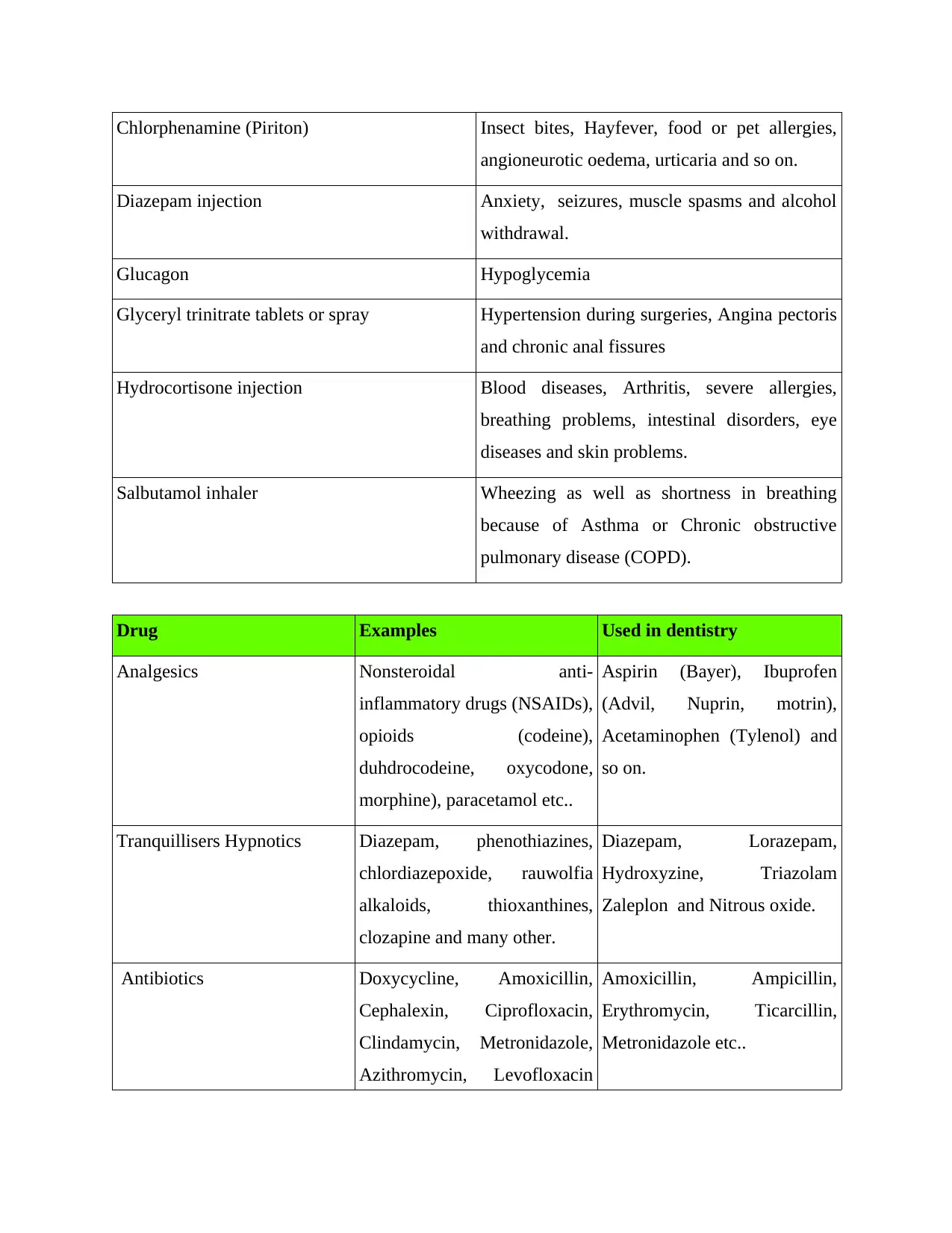
Chlorphenamine (Piriton) Insect bites, Hayfever, food or pet allergies,
angioneurotic oedema, urticaria and so on.
Diazepam injection Anxiety, seizures, muscle spasms and alcohol
withdrawal.
Glucagon Hypoglycemia
Glyceryl trinitrate tablets or spray Hypertension during surgeries, Angina pectoris
and chronic anal fissures
Hydrocortisone injection Blood diseases, Arthritis, severe allergies,
breathing problems, intestinal disorders, eye
diseases and skin problems.
Salbutamol inhaler Wheezing as well as shortness in breathing
because of Asthma or Chronic obstructive
pulmonary disease (COPD).
Drug Examples Used in dentistry
Analgesics Nonsteroidal anti-
inflammatory drugs (NSAIDs),
opioids (codeine),
duhdrocodeine, oxycodone,
morphine), paracetamol etc..
Aspirin (Bayer), Ibuprofen
(Advil, Nuprin, motrin),
Acetaminophen (Tylenol) and
so on.
Tranquillisers Hypnotics Diazepam, phenothiazines,
chlordiazepoxide, rauwolfia
alkaloids, thioxanthines,
clozapine and many other.
Diazepam, Lorazepam,
Hydroxyzine, Triazolam
Zaleplon and Nitrous oxide.
Antibiotics Doxycycline, Amoxicillin,
Cephalexin, Ciprofloxacin,
Clindamycin, Metronidazole,
Azithromycin, Levofloxacin
Amoxicillin, Ampicillin,
Erythromycin, Ticarcillin,
Metronidazole etc..
angioneurotic oedema, urticaria and so on.
Diazepam injection Anxiety, seizures, muscle spasms and alcohol
withdrawal.
Glucagon Hypoglycemia
Glyceryl trinitrate tablets or spray Hypertension during surgeries, Angina pectoris
and chronic anal fissures
Hydrocortisone injection Blood diseases, Arthritis, severe allergies,
breathing problems, intestinal disorders, eye
diseases and skin problems.
Salbutamol inhaler Wheezing as well as shortness in breathing
because of Asthma or Chronic obstructive
pulmonary disease (COPD).
Drug Examples Used in dentistry
Analgesics Nonsteroidal anti-
inflammatory drugs (NSAIDs),
opioids (codeine),
duhdrocodeine, oxycodone,
morphine), paracetamol etc..
Aspirin (Bayer), Ibuprofen
(Advil, Nuprin, motrin),
Acetaminophen (Tylenol) and
so on.
Tranquillisers Hypnotics Diazepam, phenothiazines,
chlordiazepoxide, rauwolfia
alkaloids, thioxanthines,
clozapine and many other.
Diazepam, Lorazepam,
Hydroxyzine, Triazolam
Zaleplon and Nitrous oxide.
Antibiotics Doxycycline, Amoxicillin,
Cephalexin, Ciprofloxacin,
Clindamycin, Metronidazole,
Azithromycin, Levofloxacin
Amoxicillin, Ampicillin,
Erythromycin, Ticarcillin,
Metronidazole etc..
⊘ This is a preview!⊘
Do you want full access?
Subscribe today to unlock all pages.

Trusted by 1+ million students worldwide
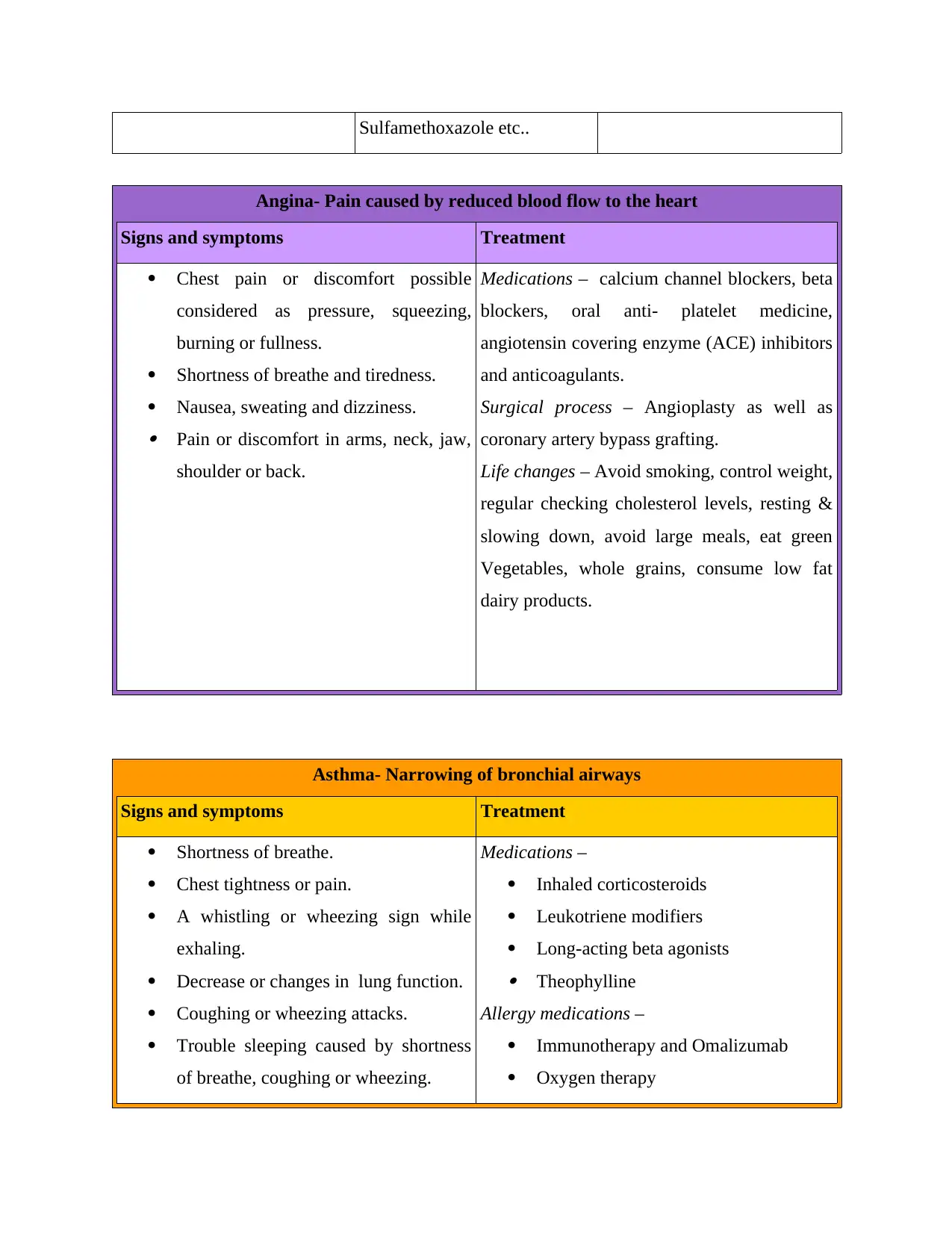
Sulfamethoxazole etc..
Angina- Pain caused by reduced blood flow to the heart
Signs and symptoms Treatment
Chest pain or discomfort possible
considered as pressure, squeezing,
burning or fullness.
Shortness of breathe and tiredness.
Nausea, sweating and dizziness. Pain or discomfort in arms, neck, jaw,
shoulder or back.
Medications – calcium channel blockers, beta
blockers, oral anti- platelet medicine,
angiotensin covering enzyme (ACE) inhibitors
and anticoagulants.
Surgical process – Angioplasty as well as
coronary artery bypass grafting.
Life changes – Avoid smoking, control weight,
regular checking cholesterol levels, resting &
slowing down, avoid large meals, eat green
Vegetables, whole grains, consume low fat
dairy products.
Asthma- Narrowing of bronchial airways
Signs and symptoms Treatment
Shortness of breathe.
Chest tightness or pain.
A whistling or wheezing sign while
exhaling.
Decrease or changes in lung function.
Coughing or wheezing attacks.
Trouble sleeping caused by shortness
of breathe, coughing or wheezing.
Medications –
Inhaled corticosteroids
Leukotriene modifiers
Long-acting beta agonists
Theophylline
Allergy medications –
Immunotherapy and Omalizumab
Oxygen therapy
Angina- Pain caused by reduced blood flow to the heart
Signs and symptoms Treatment
Chest pain or discomfort possible
considered as pressure, squeezing,
burning or fullness.
Shortness of breathe and tiredness.
Nausea, sweating and dizziness. Pain or discomfort in arms, neck, jaw,
shoulder or back.
Medications – calcium channel blockers, beta
blockers, oral anti- platelet medicine,
angiotensin covering enzyme (ACE) inhibitors
and anticoagulants.
Surgical process – Angioplasty as well as
coronary artery bypass grafting.
Life changes – Avoid smoking, control weight,
regular checking cholesterol levels, resting &
slowing down, avoid large meals, eat green
Vegetables, whole grains, consume low fat
dairy products.
Asthma- Narrowing of bronchial airways
Signs and symptoms Treatment
Shortness of breathe.
Chest tightness or pain.
A whistling or wheezing sign while
exhaling.
Decrease or changes in lung function.
Coughing or wheezing attacks.
Trouble sleeping caused by shortness
of breathe, coughing or wheezing.
Medications –
Inhaled corticosteroids
Leukotriene modifiers
Long-acting beta agonists
Theophylline
Allergy medications –
Immunotherapy and Omalizumab
Oxygen therapy
Paraphrase This Document
Need a fresh take? Get an instant paraphrase of this document with our AI Paraphraser
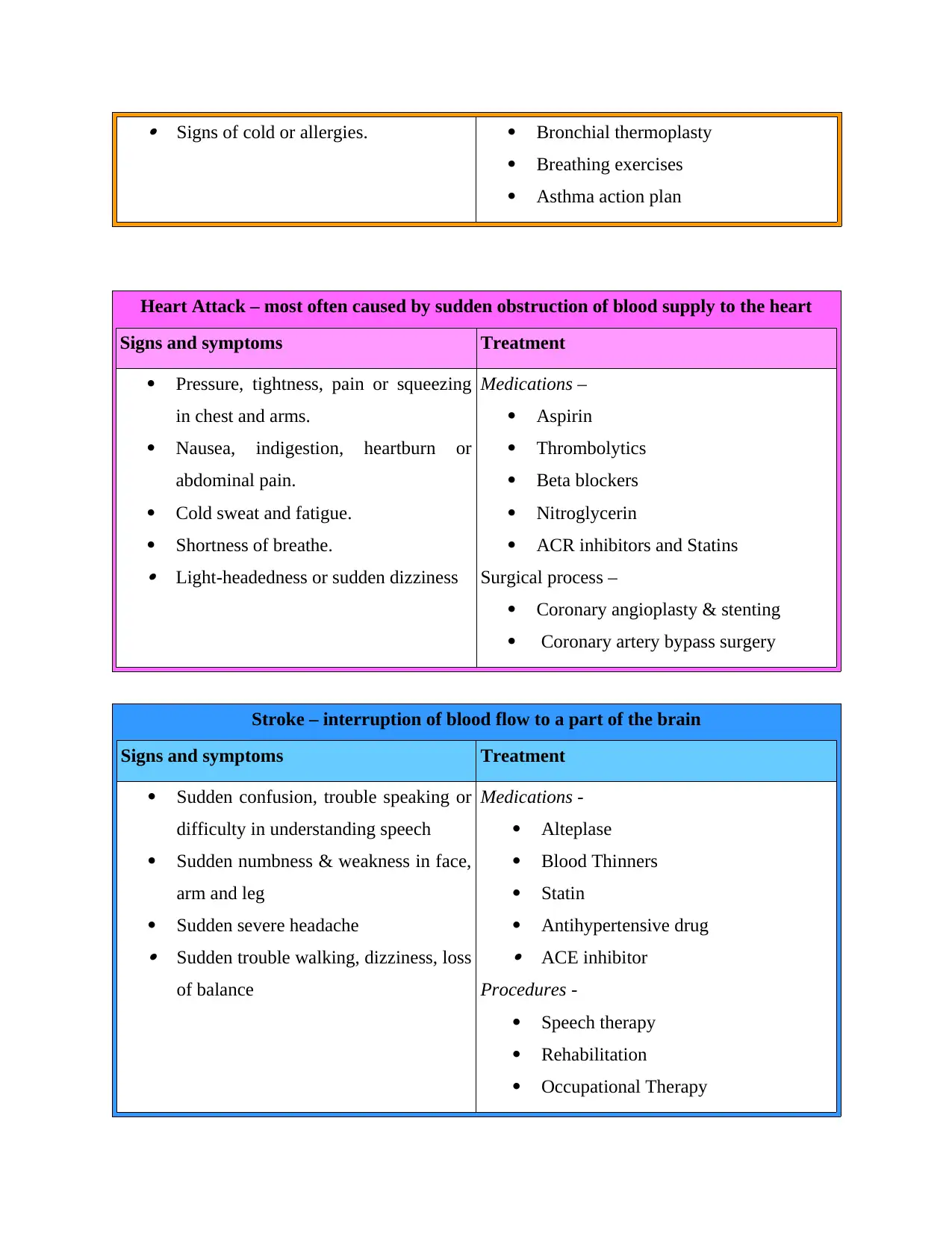
Signs of cold or allergies. Bronchial thermoplasty
Breathing exercises
Asthma action plan
Heart Attack – most often caused by sudden obstruction of blood supply to the heart
Signs and symptoms Treatment
Pressure, tightness, pain or squeezing
in chest and arms.
Nausea, indigestion, heartburn or
abdominal pain.
Cold sweat and fatigue.
Shortness of breathe. Light-headedness or sudden dizziness
Medications –
Aspirin
Thrombolytics
Beta blockers
Nitroglycerin
ACR inhibitors and Statins
Surgical process –
Coronary angioplasty & stenting
Coronary artery bypass surgery
Stroke – interruption of blood flow to a part of the brain
Signs and symptoms Treatment
Sudden confusion, trouble speaking or
difficulty in understanding speech
Sudden numbness & weakness in face,
arm and leg
Sudden severe headache Sudden trouble walking, dizziness, loss
of balance
Medications -
Alteplase
Blood Thinners
Statin
Antihypertensive drug
ACE inhibitor
Procedures -
Speech therapy
Rehabilitation
Occupational Therapy
Breathing exercises
Asthma action plan
Heart Attack – most often caused by sudden obstruction of blood supply to the heart
Signs and symptoms Treatment
Pressure, tightness, pain or squeezing
in chest and arms.
Nausea, indigestion, heartburn or
abdominal pain.
Cold sweat and fatigue.
Shortness of breathe. Light-headedness or sudden dizziness
Medications –
Aspirin
Thrombolytics
Beta blockers
Nitroglycerin
ACR inhibitors and Statins
Surgical process –
Coronary angioplasty & stenting
Coronary artery bypass surgery
Stroke – interruption of blood flow to a part of the brain
Signs and symptoms Treatment
Sudden confusion, trouble speaking or
difficulty in understanding speech
Sudden numbness & weakness in face,
arm and leg
Sudden severe headache Sudden trouble walking, dizziness, loss
of balance
Medications -
Alteplase
Blood Thinners
Statin
Antihypertensive drug
ACE inhibitor
Procedures -
Speech therapy
Rehabilitation
Occupational Therapy
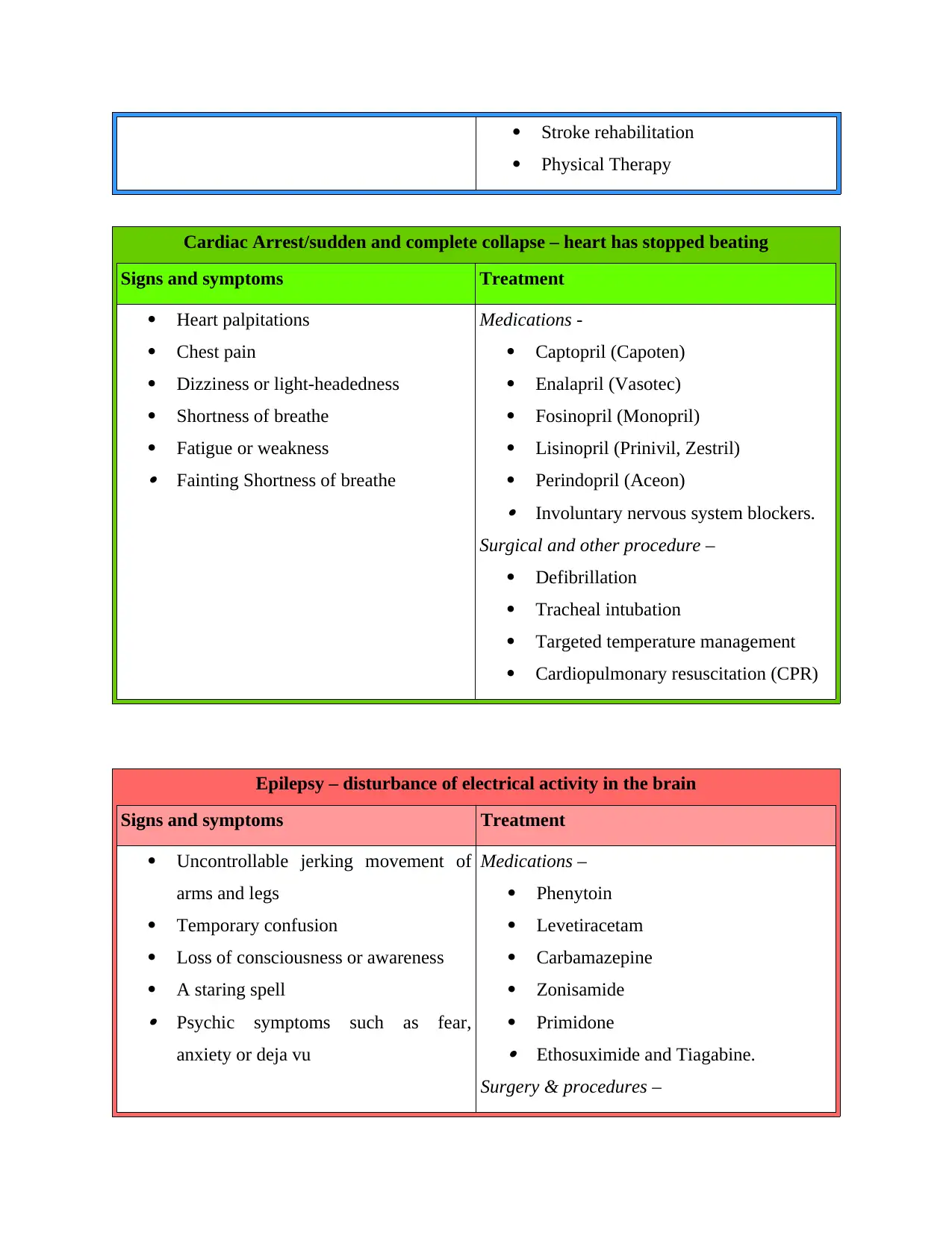
Stroke rehabilitation
Physical Therapy
Cardiac Arrest/sudden and complete collapse – heart has stopped beating
Signs and symptoms Treatment
Heart palpitations
Chest pain
Dizziness or light-headedness
Shortness of breathe
Fatigue or weakness Fainting Shortness of breathe
Medications -
Captopril (Capoten)
Enalapril (Vasotec)
Fosinopril (Monopril)
Lisinopril (Prinivil, Zestril)
Perindopril (Aceon)
Involuntary nervous system blockers.
Surgical and other procedure –
Defibrillation
Tracheal intubation
Targeted temperature management
Cardiopulmonary resuscitation (CPR)
Epilepsy – disturbance of electrical activity in the brain
Signs and symptoms Treatment
Uncontrollable jerking movement of
arms and legs
Temporary confusion
Loss of consciousness or awareness
A staring spell Psychic symptoms such as fear,
anxiety or deja vu
Medications –
Phenytoin
Levetiracetam
Carbamazepine
Zonisamide
Primidone
Ethosuximide and Tiagabine.
Surgery & procedures –
Physical Therapy
Cardiac Arrest/sudden and complete collapse – heart has stopped beating
Signs and symptoms Treatment
Heart palpitations
Chest pain
Dizziness or light-headedness
Shortness of breathe
Fatigue or weakness Fainting Shortness of breathe
Medications -
Captopril (Capoten)
Enalapril (Vasotec)
Fosinopril (Monopril)
Lisinopril (Prinivil, Zestril)
Perindopril (Aceon)
Involuntary nervous system blockers.
Surgical and other procedure –
Defibrillation
Tracheal intubation
Targeted temperature management
Cardiopulmonary resuscitation (CPR)
Epilepsy – disturbance of electrical activity in the brain
Signs and symptoms Treatment
Uncontrollable jerking movement of
arms and legs
Temporary confusion
Loss of consciousness or awareness
A staring spell Psychic symptoms such as fear,
anxiety or deja vu
Medications –
Phenytoin
Levetiracetam
Carbamazepine
Zonisamide
Primidone
Ethosuximide and Tiagabine.
Surgery & procedures –
⊘ This is a preview!⊘
Do you want full access?
Subscribe today to unlock all pages.

Trusted by 1+ million students worldwide
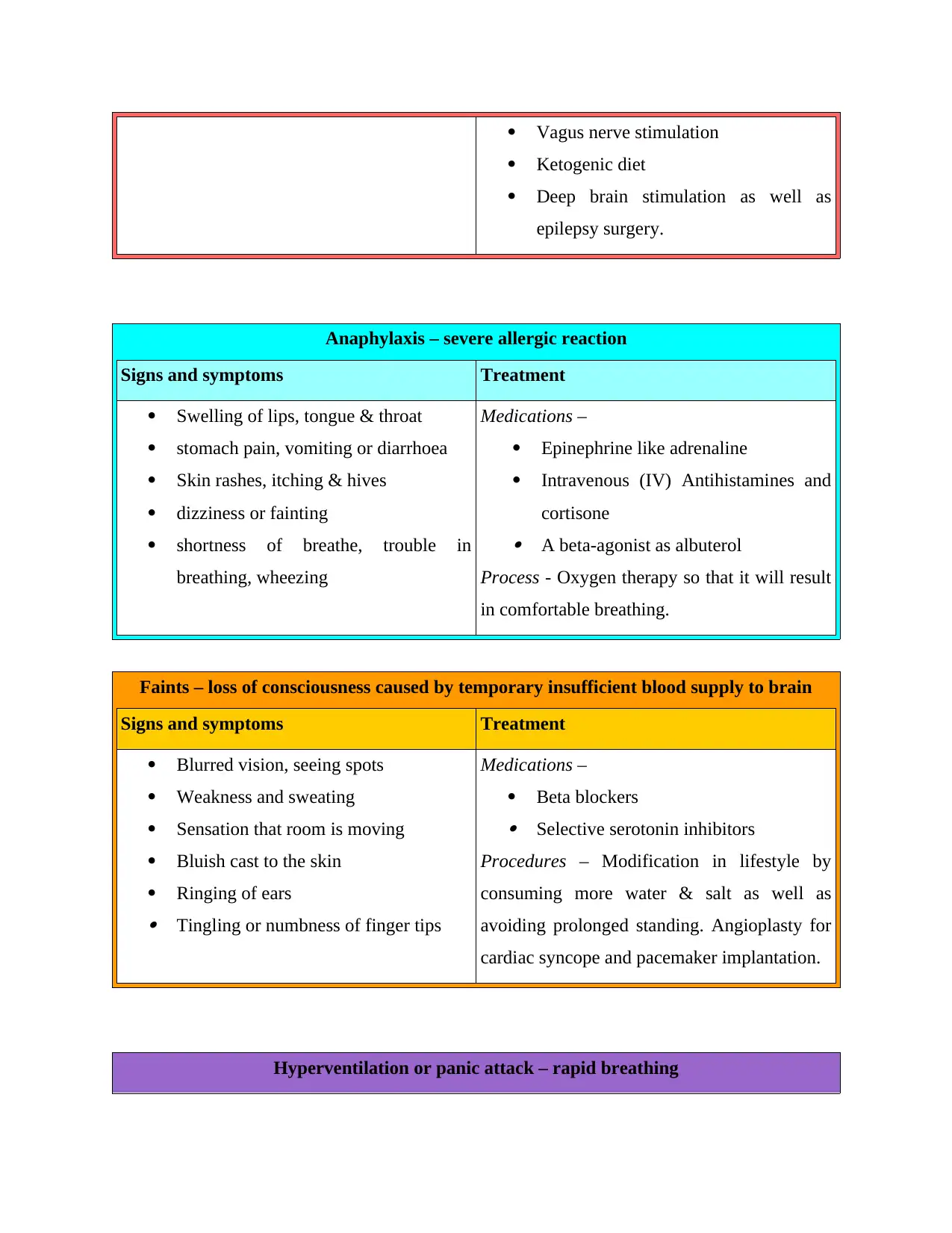
Vagus nerve stimulation
Ketogenic diet
Deep brain stimulation as well as
epilepsy surgery.
Anaphylaxis – severe allergic reaction
Signs and symptoms Treatment
Swelling of lips, tongue & throat
stomach pain, vomiting or diarrhoea
Skin rashes, itching & hives
dizziness or fainting
shortness of breathe, trouble in
breathing, wheezing
Medications –
Epinephrine like adrenaline
Intravenous (IV) Antihistamines and
cortisone
A beta-agonist as albuterol
Process - Oxygen therapy so that it will result
in comfortable breathing.
Faints – loss of consciousness caused by temporary insufficient blood supply to brain
Signs and symptoms Treatment
Blurred vision, seeing spots
Weakness and sweating
Sensation that room is moving
Bluish cast to the skin
Ringing of ears Tingling or numbness of finger tips
Medications –
Beta blockers
Selective serotonin inhibitors
Procedures – Modification in lifestyle by
consuming more water & salt as well as
avoiding prolonged standing. Angioplasty for
cardiac syncope and pacemaker implantation.
Hyperventilation or panic attack – rapid breathing
Ketogenic diet
Deep brain stimulation as well as
epilepsy surgery.
Anaphylaxis – severe allergic reaction
Signs and symptoms Treatment
Swelling of lips, tongue & throat
stomach pain, vomiting or diarrhoea
Skin rashes, itching & hives
dizziness or fainting
shortness of breathe, trouble in
breathing, wheezing
Medications –
Epinephrine like adrenaline
Intravenous (IV) Antihistamines and
cortisone
A beta-agonist as albuterol
Process - Oxygen therapy so that it will result
in comfortable breathing.
Faints – loss of consciousness caused by temporary insufficient blood supply to brain
Signs and symptoms Treatment
Blurred vision, seeing spots
Weakness and sweating
Sensation that room is moving
Bluish cast to the skin
Ringing of ears Tingling or numbness of finger tips
Medications –
Beta blockers
Selective serotonin inhibitors
Procedures – Modification in lifestyle by
consuming more water & salt as well as
avoiding prolonged standing. Angioplasty for
cardiac syncope and pacemaker implantation.
Hyperventilation or panic attack – rapid breathing
Paraphrase This Document
Need a fresh take? Get an instant paraphrase of this document with our AI Paraphraser
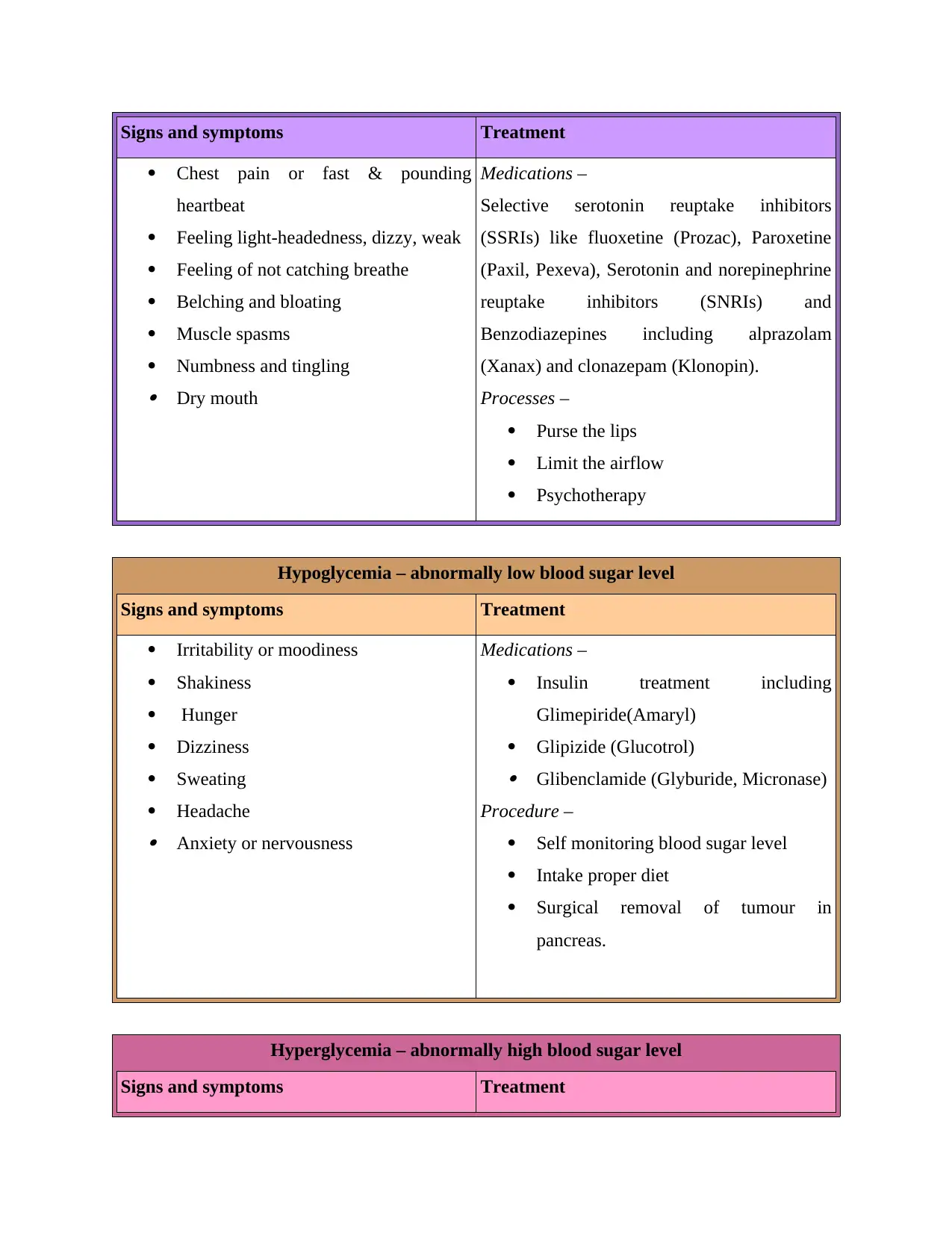
Signs and symptoms Treatment
Chest pain or fast & pounding
heartbeat
Feeling light-headedness, dizzy, weak
Feeling of not catching breathe
Belching and bloating
Muscle spasms
Numbness and tingling Dry mouth
Medications –
Selective serotonin reuptake inhibitors
(SSRIs) like fluoxetine (Prozac), Paroxetine
(Paxil, Pexeva), Serotonin and norepinephrine
reuptake inhibitors (SNRIs) and
Benzodiazepines including alprazolam
(Xanax) and clonazepam (Klonopin).
Processes –
Purse the lips
Limit the airflow
Psychotherapy
Hypoglycemia – abnormally low blood sugar level
Signs and symptoms Treatment
Irritability or moodiness
Shakiness
Hunger
Dizziness
Sweating
Headache Anxiety or nervousness
Medications –
Insulin treatment including
Glimepiride(Amaryl)
Glipizide (Glucotrol)
Glibenclamide (Glyburide, Micronase)
Procedure –
Self monitoring blood sugar level
Intake proper diet
Surgical removal of tumour in
pancreas.
Hyperglycemia – abnormally high blood sugar level
Signs and symptoms Treatment
Chest pain or fast & pounding
heartbeat
Feeling light-headedness, dizzy, weak
Feeling of not catching breathe
Belching and bloating
Muscle spasms
Numbness and tingling Dry mouth
Medications –
Selective serotonin reuptake inhibitors
(SSRIs) like fluoxetine (Prozac), Paroxetine
(Paxil, Pexeva), Serotonin and norepinephrine
reuptake inhibitors (SNRIs) and
Benzodiazepines including alprazolam
(Xanax) and clonazepam (Klonopin).
Processes –
Purse the lips
Limit the airflow
Psychotherapy
Hypoglycemia – abnormally low blood sugar level
Signs and symptoms Treatment
Irritability or moodiness
Shakiness
Hunger
Dizziness
Sweating
Headache Anxiety or nervousness
Medications –
Insulin treatment including
Glimepiride(Amaryl)
Glipizide (Glucotrol)
Glibenclamide (Glyburide, Micronase)
Procedure –
Self monitoring blood sugar level
Intake proper diet
Surgical removal of tumour in
pancreas.
Hyperglycemia – abnormally high blood sugar level
Signs and symptoms Treatment
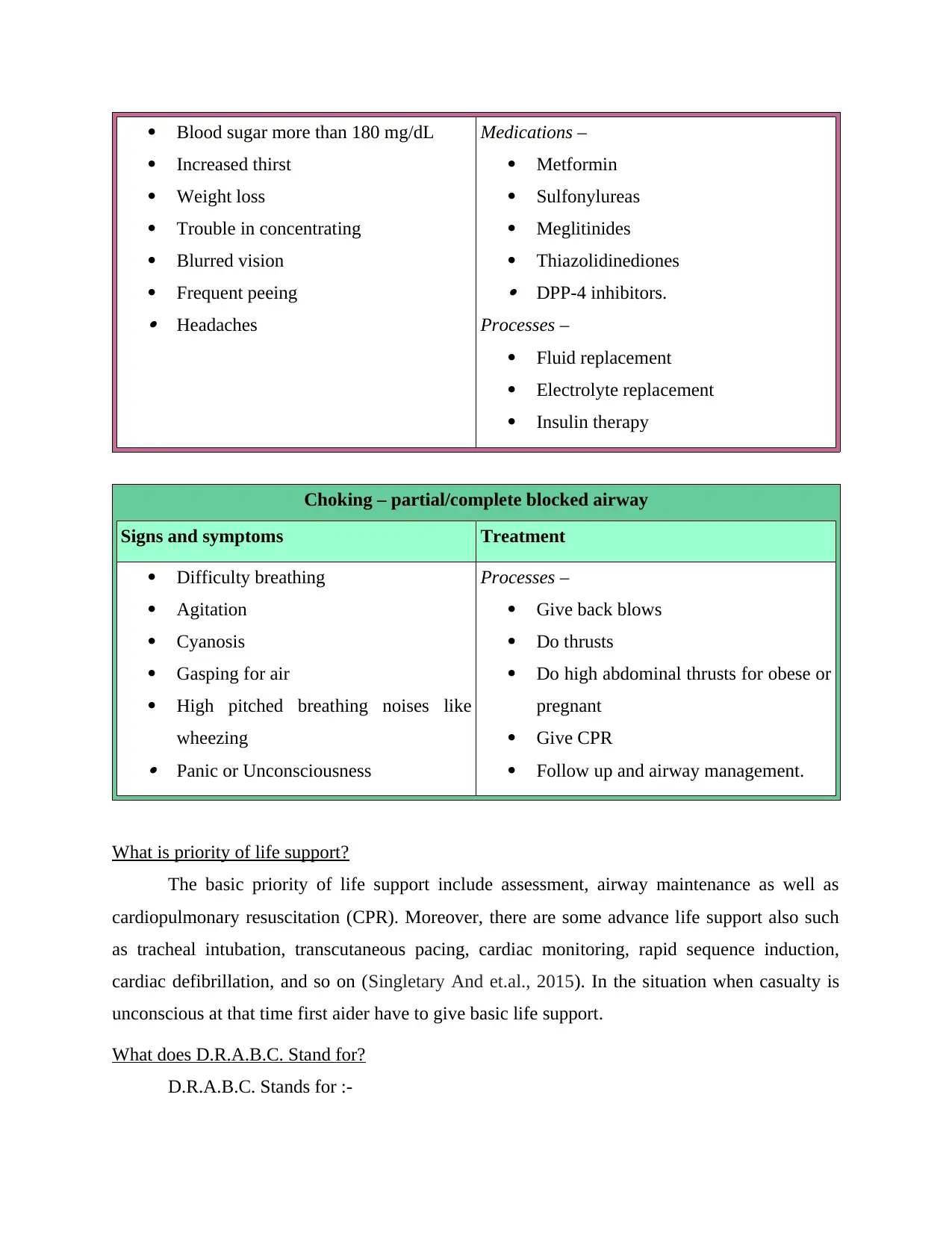
Blood sugar more than 180 mg/dL
Increased thirst
Weight loss
Trouble in concentrating
Blurred vision
Frequent peeing Headaches
Medications –
Metformin
Sulfonylureas
Meglitinides
Thiazolidinediones
DPP-4 inhibitors.
Processes –
Fluid replacement
Electrolyte replacement
Insulin therapy
Choking – partial/complete blocked airway
Signs and symptoms Treatment
Difficulty breathing
Agitation
Cyanosis
Gasping for air
High pitched breathing noises like
wheezing Panic or Unconsciousness
Processes –
Give back blows
Do thrusts
Do high abdominal thrusts for obese or
pregnant
Give CPR
Follow up and airway management.
What is priority of life support?
The basic priority of life support include assessment, airway maintenance as well as
cardiopulmonary resuscitation (CPR). Moreover, there are some advance life support also such
as tracheal intubation, transcutaneous pacing, cardiac monitoring, rapid sequence induction,
cardiac defibrillation, and so on (Singletary And et.al., 2015). In the situation when casualty is
unconscious at that time first aider have to give basic life support.
What does D.R.A.B.C. Stand for?
D.R.A.B.C. Stands for :-
Increased thirst
Weight loss
Trouble in concentrating
Blurred vision
Frequent peeing Headaches
Medications –
Metformin
Sulfonylureas
Meglitinides
Thiazolidinediones
DPP-4 inhibitors.
Processes –
Fluid replacement
Electrolyte replacement
Insulin therapy
Choking – partial/complete blocked airway
Signs and symptoms Treatment
Difficulty breathing
Agitation
Cyanosis
Gasping for air
High pitched breathing noises like
wheezing Panic or Unconsciousness
Processes –
Give back blows
Do thrusts
Do high abdominal thrusts for obese or
pregnant
Give CPR
Follow up and airway management.
What is priority of life support?
The basic priority of life support include assessment, airway maintenance as well as
cardiopulmonary resuscitation (CPR). Moreover, there are some advance life support also such
as tracheal intubation, transcutaneous pacing, cardiac monitoring, rapid sequence induction,
cardiac defibrillation, and so on (Singletary And et.al., 2015). In the situation when casualty is
unconscious at that time first aider have to give basic life support.
What does D.R.A.B.C. Stand for?
D.R.A.B.C. Stands for :-
⊘ This is a preview!⊘
Do you want full access?
Subscribe today to unlock all pages.

Trusted by 1+ million students worldwide
1 out of 24
Related Documents
Your All-in-One AI-Powered Toolkit for Academic Success.
+13062052269
info@desklib.com
Available 24*7 on WhatsApp / Email
![[object Object]](/_next/static/media/star-bottom.7253800d.svg)
Unlock your academic potential
Copyright © 2020–2025 A2Z Services. All Rights Reserved. Developed and managed by ZUCOL.





